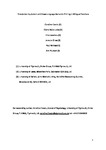Translation equivalent and cross-language semantic priming in bilingual toddlers
| dc.contributor.author | Floccia, Caroline | |
| dc.contributor.author | Delle Luche, C | |
| dc.contributor.author | Lepadatu, I | |
| dc.contributor.author | Chow, J | |
| dc.contributor.author | Ratnage, P | |
| dc.contributor.author | Plunkett, K | |
| dc.date.accessioned | 2019-12-17T12:34:03Z | |
| dc.date.issued | 2020-06 | |
| dc.identifier.issn | 0749-596X | |
| dc.identifier.issn | 1096-0821 | |
| dc.identifier.other | 104086 | |
| dc.identifier.uri | http://hdl.handle.net/10026.1/15256 | |
| dc.description.abstract |
In adult bilinguals, a word in one language will activate a related word in the other language, with language dominance modulating the direction of these effects. To determine whether the early bilingual lexicon possesses similar properties to its adult counterpart, two experiments compared translation equivalent priming and cross-linguistic semantic priming in 27-month-old bilingual toddlers learning English and one other language. Priming effects were found in both experiments, irrespective of language dominance and distance between the child's two languages. The time course of target word recognition revealed a similar pattern for translation equivalent priming and cross-language semantic priming. These results suggest that the early bilingual lexicon possesses properties similar to the adult one in terms of word to concept connections. However, the absence of an advantage of translation equivalent priming over semantic priming, and the lack of dominance and language distance effects, suggest that when two languages are acquired in parallel during infancy, their integration within a single dynamic system is highly robust to input variations. | |
| dc.format.extent | 104086-104086 | |
| dc.language | en | |
| dc.language.iso | en | |
| dc.publisher | Elsevier | |
| dc.subject | Bilingual lexicon | |
| dc.subject | Toddlers | |
| dc.subject | Word processing | |
| dc.subject | Priming | |
| dc.subject | Language dominance | |
| dc.subject | Language distance | |
| dc.title | Translation equivalent and cross-language semantic priming in bilingual toddlers | |
| dc.type | journal-article | |
| dc.type | Journal Article | |
| plymouth.author-url | https://www.webofscience.com/api/gateway?GWVersion=2&SrcApp=PARTNER_APP&SrcAuth=LinksAMR&KeyUT=WOS:000527909900001&DestLinkType=FullRecord&DestApp=ALL_WOS&UsrCustomerID=11bb513d99f797142bcfeffcc58ea008 | |
| plymouth.volume | 112 | |
| plymouth.publication-status | Published | |
| plymouth.journal | Journal of Memory and Language | |
| dc.identifier.doi | 10.1016/j.jml.2019.104086 | |
| plymouth.organisational-group | /Plymouth | |
| plymouth.organisational-group | /Plymouth/Faculty of Health | |
| plymouth.organisational-group | /Plymouth/Faculty of Health/School of Psychology | |
| plymouth.organisational-group | /Plymouth/REF 2021 Researchers by UoA | |
| plymouth.organisational-group | /Plymouth/REF 2021 Researchers by UoA/UoA04 Psychology, Psychiatry and Neuroscience | |
| plymouth.organisational-group | /Plymouth/REF 2021 Researchers by UoA/UoA04 Psychology, Psychiatry and Neuroscience/UoA04 REF peer reviewers | |
| plymouth.organisational-group | /Plymouth/Research Groups | |
| plymouth.organisational-group | /Plymouth/Research Groups/Centre for Brain, Cognition and Behaviour (CBCB) | |
| plymouth.organisational-group | /Plymouth/Research Groups/Centre for Brain, Cognition and Behaviour (CBCB)/Cognition | |
| plymouth.organisational-group | /Plymouth/Research Groups/Plymouth Institute of Health and Care Research (PIHR) | |
| plymouth.organisational-group | /Plymouth/Users by role | |
| plymouth.organisational-group | /Plymouth/Users by role/Academics | |
| dcterms.dateAccepted | 2019-12-16 | |
| dc.rights.embargodate | 2021-1-8 | |
| dc.identifier.eissn | 1096-0821 | |
| dc.rights.embargoperiod | Not known | |
| rioxxterms.versionofrecord | 10.1016/j.jml.2019.104086 | |
| rioxxterms.licenseref.uri | http://www.rioxx.net/licenses/all-rights-reserved | |
| rioxxterms.licenseref.startdate | 2020-06 | |
| rioxxterms.type | Journal Article/Review | |
| plymouth.funder | Lexicon development in bilingual toddler::ESRC |


